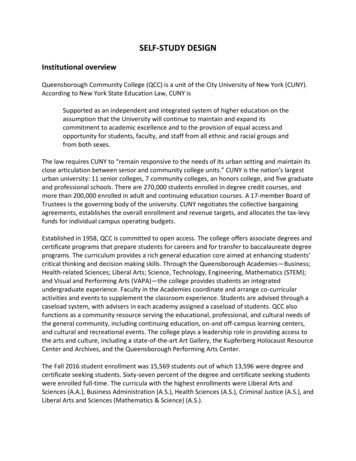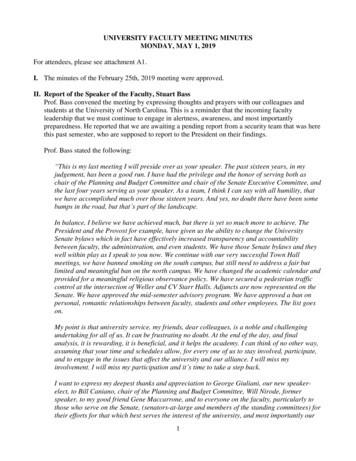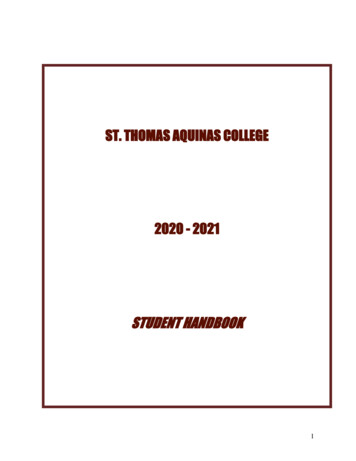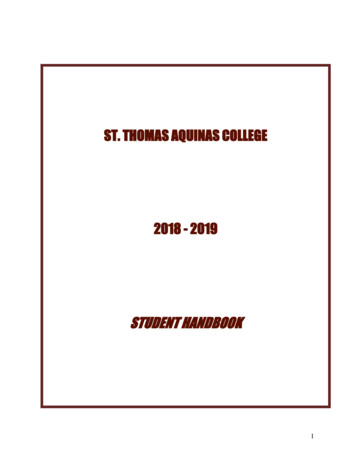
Transcription
SELF-STUDY DESIGNInstitutional overviewQueensborough Community College (QCC) is a unit of the City University of New York (CUNY).According to New York State Education Law, CUNY isSupported as an independent and integrated system of higher education on theassumption that the University will continue to maintain and expand itscommitment to academic excellence and to the provision of equal access andopportunity for students, faculty, and staff from all ethnic and racial groups andfrom both sexes.The law requires CUNY to “remain responsive to the needs of its urban setting and maintain itsclose articulation between senior and community college units.” CUNY is the nation’s largesturban university: 11 senior colleges, 7 community colleges, an honors college, and five graduateand professional schools. There are 270,000 students enrolled in degree credit courses, andmore than 200,000 enrolled in adult and continuing education courses. A 17-member Board ofTrustees is the governing body of the university. CUNY negotiates the collective bargainingagreements, establishes the overall enrollment and revenue targets, and allocates the tax-levyfunds for individual campus operating budgets.Established in 1958, QCC is committed to open access. The college offers associate degrees andcertificate programs that prepare students for careers and for transfer to baccalaureate degreeprograms. The curriculum provides a rich general education core aimed at enhancing students’critical thinking and decision making skills. Through the Queensborough Academies—Business;Health-related Sciences; Liberal Arts; Science, Technology, Engineering, Mathematics (STEM);and Visual and Performing Arts (VAPA)—the college provides students an integratedundergraduate experience. Faculty in the Academies coordinate and arrange co-curricularactivities and events to supplement the classroom experience. Students are advised through acaseload system, with advisers in each academy assigned a caseload of students. QCC alsofunctions as a community resource serving the educational, professional, and cultural needs ofthe general community, including continuing education, on-and off-campus learning centers,and cultural and recreational events. The college plays a leadership role in providing access tothe arts and culture, including a state-of-the-art Art Gallery, the Kupferberg Holocaust ResourceCenter and Archives, and the Queensborough Performing Arts Center.The Fall 2016 student enrollment was 15,569 students out of which 13,596 were degree andcertificate seeking students. Sixty-seven percent of the degree and certificate seeking studentswere enrolled full-time. The curricula with the highest enrollments were Liberal Arts andSciences (A.A.), Business Administration (A.S.), Health Sciences (A.S.), Criminal Justice (A.S.), andLiberal Arts and Sciences (Mathematics & Science) (A.S.).
Some facts about the institution include: A total of 1,973 students were non-degree. The majority of this group were high schoolstudents who were part of the College Now program, which enrolls high school studentsin college courses.QCC is a very diverse campus with students from 129 countries. The majority live inQueens. Thirty-five percent report speaking a language other than English at home.QCC is an open-admissions campus; over seventy percent of the incoming freshmenrequire at least one remedial course. In the academic year 2015-16, 79 percent of allfirst-time full-time freshmen and 55 percent of all degree students received some formof financial grant aid.The six-year graduation rate for the Fall 2010 cohort was 32.2 percent from QCC with anadditional 8.5 percent that graduated elsewhere in CUNY or outside CUNY. This bringsthe overall six-year graduation rate to 40.7 percent. QCC students usually go on to otherCUNY senior colleges like Queens College and Baruch College, but also enroll in nonCUNY colleges (e.g. SUNY Stony Brook, SUNY Binghamton, Adelphi, Long IslandUniversity, NYU, and St. John’s).QCC graduated 2,268 students in the academic year 2015-16, the highest number ofgraduates in one academic year since the inception of the college. The curricula with themost degrees were Liberal Arts and Sciences (825), Business Administration (342), andCriminal Justice (218).Sixty-three percent of the full-time faculty at QCC have earned doctoral degrees.Another 17 percent have terminal degrees in such fields as nursing, engineering, and thevisual and performing arts.The self-study design that follows is the blueprint for the development of the self-study reportthat the college will undertake over the next two years. The design conceptualizes andorganizes the self-study tasks that the working groups will carry out in the development of theindividual chapters—one to each working group, each one devoted to one standard and therelevant requirements of affiliation—that will constitute the self-study report.Specifically, the design will organize and direct efforts regarding: Outcomes of the self-studyOrganizational structure of the self-study processCharges to the working groups and guidelines for reportingOrganization of the final self-study reportEditorial style and format of the self-studyTimetable for the self-studyProfile of the evaluation teamDocumentation Roadmap2
In each case, the design makes clear what the expectations are that will guide the workinggroups in their development of the chapter of the self-study to which they have been assigned.As explained in the corresponding sections of the design below, each chapter of the self-studywill be devoted to a Middle States standard and the relevant requirements of affiliation. Theaccompanying Documentation Roadmap will demonstrate, criterion by criterion of thestandard, the ways in which the institution complies with Standards of Accreditation and therelevant Requirements of Affiliation. The initial task of the working groups will be to review andmake changes to the documentation in the Roadmap to ensure the best possible examples ofdocumentation to show compliance with the criterion indicated. The review also serves as agap analysis to identify areas lacking appropriate or sufficient documentation and, through theworking group co-chairs, to convey this gap analysis to the executive co-chairs. It is theresponsibility of the executive co-chairs to address these analyses and to follow up with theappropriate campus office to obtain appropriate documentation to be added to the roadmap.In the end, the Documentation Roadmap becomes the key to showing how the institutionholistically meets the Middle States standards and the relevant requirements of affiliation.The self-study chapters, however, are intended to demonstrate how the institution meets andfulfills its mission and goals and campus priorities. Given specific examples of evidence andanalysis of processes at work, the chapters should demonstrate the ways in which theinstitution uses data and evidence, at any level, to make informed decisions about the degreeto which it is meeting its goals and priorities and, where necessary, to modify its practices toimprove institutional effectiveness.To help shape this kind of examination of the institution, several initiatives that have been thefocus of campus-wide efforts over a number of years will be used as guiding themes for theself-study chapters. These initiatives, part of the college’s strategic planning for several years,include: Faculty and staff development: supporting faculty to tenure and promotion, promotingHIPs and pedagogical innovation, training and supporting administrative professionalsfor the growing challenges of higher educationQueensborough Academies: shaping the student experience for success throughfocused and expanded use of data governance and redoubled efforts on remediationand improving student preparednessThese institutional priorities focus the self-study chapters. In the charge to each working group,however, the initiatives above will be framed in more specific ways through leading questionsto help the group to focus and shape the chapter in a way that is appropriate to the standardand relevant requirements of affiliation under review. Each working group will also be chargedwith developing a chapter narrative that addresses the assessment of the standard.3
Intended outcomes of the self-studyThe overall goals of the self-study process are reaffirmation of accreditation, institutional selfappraisal, and recommendations for institutional improvement. The self-study design isintended to establish a clear direction for the self-study process and to allow the institution toassess its own progress since the Periodic Review Report, in 2014.The more specific outcomes below are based on the premise that the institution plans, throughself-analysis, to integrate the self-study process with other institutional planning and renewalprocesses, ensuring that the self-study itself will be as useful and meaningful as possible to theinstitution. Engage in an inclusive and transparent self-appraisal process that actively anddeliberately seeks to involve members from all areas of the campus communityDemonstrate how the institution currently meets Middle States Standards forAccreditation and the Requirements of Affiliation with a focus on continuousimprovement in the attainment of the institutional mission and prioritiesProvide a concise and accurate analysis of the institution that can guide institutionalplanning, growth, and renewal effortsAssess the quality and effectiveness of academic programs and administrative services,at all degree levels and in all departments, particularly in relation to the changing needsof the institution’s student body and communityDocument current assessment practices to identify challenges and opportunities andareas for improvement in the use of institutional assessment resultsAnalyze the quality and effectiveness of the institution’s processes for planning andassessment to make necessary adjustments to methods and measurements and toensure that the use of assessment data will lead to meaningful programmatic andinstitutional renewalCapitalize on the overlapping efforts of strategic planning and the Middle States SelfStudy to inform decision-making; to identify specific opportunities and challenges,including budgeting and enrollment; and, if appropriate, to reshape strategic planningMake recommendations that are high level, tied to institutional priorities, are missioncritical, and are limited in numberAs a general guide to the success of the self-study process, some advice is provided below.1 It isintended to inform the thinking of the executive co-chairs and the self-study steeringcommittee, but also all the members of the working groups.PitfallViewing the self-study as peripheral to the institution’s work1Adapted from Self-study: Creating a useful Process and Report, Middle States Commission on Higher Education,for Institutions with Visit in 2018-19, 2016, 44-46.4
Helpful adviceThe very heart of the self-study process is the intention to use that process for an honest andcomprehensive self-appraisal of the institution, articulating strengths and weaknesses andformulating recommendations for institutional improvement. The evaluation team, comprisingpeers who have experience in similar institutions, helps the institution to use the process forlong-term impact on overall effectiveness and student learning.PitfallDescribing what the institution does without analyzing the evidence of assessment processes atworkHelpful adviceRather than focusing on a description of what the institution does, the self-study should analyzehow institutional operations affect students and how well operations align with mission andgoals. To ensure meaningful analysis, information should come from institutional, unit, andprogram assessments.PitfallMaking unsupported assertions about student learning and achievement and/or academicprograms and their effectivenessHelpful adviceDemonstrate how the evidence is being considered and used by key institutional stakeholdersto achieve mission and key goals and to promote institutional change and improvement.PitfallUsing confusing or conflicting data and statistical jargonHelpful adviceAlways confirming data sources and their accuracy, provide clear and concise analyses toexplain what is learned about students and their achievements, programs, and theireffectiveness and whether the institution’s mission and goals are being achieved in classroomsand co-curricular programs.PitfallDeveloping a self-study that focuses on non-specific aspirations rather than on specific issuesthat are important to the institution and related to mission, key strategic goals, objectives, orpriorities.Helpful adviceThe Middle States Commission expects that the self-study process is framed by mission and theinstitution’s key goals, objectives, and priorities. Institutional plans should reflect alignment ofgoals, curricula, services, and assessments. Through the evaluation of institutional strengths5
and weaknesses, the self-study recommendations should focus on ways that the institution canensure further continuous improvement.PitfallAssuming that the institution is too “special” to establish and use benchmarksHelpful adviceUse benchmarks to set specific goals for strategic planning and use those goals for valid anduseful assessment. If published and widely available benchmarks do not provide meaningfulinstitutional cohort comparisons, construct more useful cohorts from a variety of sources. Ifsuitable benchmarks for appropriate cohorts are not available, develop other frames ofreference like comparisons over time and among relevant sub-populations within an institution.PitfallAllowing a subgroup or individual to stand in the way of the wholeHelpful adviceEstablish early in the process how the recommendations of the self-study report will bedetermined. Constituencies should hold each other accountable for constructive participationin the self-study.PitfallWriting a final self-study report that is lengthy and significantly exceeds the Middle StatesCommission’s page limit for self-studies and/or providing supporting documentation that isvoluminous and generally disorganizedHelpful adviceThe final self-study report should not exceed 100 single-spaced pages or 200 double-spacedpages, and supporting documents should be well organized and directly relate to assertions, tospecific compliance review requirements, or to the Standards for Accreditation andRequirements of Affiliation.6
Organizational structure of the Steering Committee and Working GroupsThe self-study process will be guided by the Self-study Steering Committee, consisting of theexecutive co-chairs, the working group co-chairs, and administrative representation from areaslike institutional research, marketing and communication, and finance and administration. Oneof the executive co-chairs, dean for accreditation, assessment, and institutional effectiveness,recruited two seasoned faculty members to serve as executive co-chairs. The executive cochairs recruited the working group co-chairs, one faculty member and one administrator foreach working group. Each working group, consisting of faculty and staff, will be devoted to oneMiddle States standard and the relevant requirements of affiliation.The executive co-chairs will meet periodically with the steering committee to address issues asthey arise, to monitor the progress of the working groups, and to review drafts of documents asneeded.Working groups will communicate with the executive co-chairs on all matters through theirworking group co-chairs. Any requests for data to Institutional Research from the workinggroup co-chairs will be sent to the executive co-chairs, who will forward the request toInstitutional Research.The goal of the executive co-chairs is to provide leadership and guidance to a smooth self-studyprocess toward the successful completion of the self-study report.Self-study Steering CommitteeExecutive Co-chairsAnsani, AntonellaForeign Languages and LiteratureCorradetti, ArthurStrategic Planning, Assessment, and Institutional EffectivenessFord, KellyBusinessCommittee MembersBeckford, IanStrategic Planning, Assessment, and Institutional EffectivenessBlake-Campbell, BarbaraNursingCapozzoli, GinaCounseling CenterCarpentier, MarcBudget and Financial ServicesCook, BonnieStudent Learning CenterDi Dio, StephenMarketing and Communications7
Faulkner, WilliamFinance and AdministrationGilleaudeau, JohnSocial SciencesKaur, SimranBiological Sciences and GeologyKerr, BrianStudent DevelopmentLackner, ElisabethInstitutional Research and AssessmentLandy, KathleenCenter for Excellence in Teaching and LearningMessier, VartanEnglishLynch, TimothyAcademic AffairsPantaleo, JosephineAffirmative Action, Pluralism, and Diversity Compliance OfficeSalis, AndreaHealth, Physical Education, and DanceSarno, DavidChemistryShi, LucyAccounting, Related Entities, Asset and Risk ManagementSelf-study Working Group ParticipantsTo populate the working groups, a call for volunteers was distributed to the entire campuscommunity by the executive co-chairs. Each volunteer had three choices of working group, inorder of preference. Volunteers were assigned to working groups according to theirpreferences, in some cases being assigned to a second or third choice to ensure that workinggroups are relatively consistent in size. Based on the meeting times established by each workinggroup, the executive co-chairs will work with Student Activities to assign a small team ofStudent Government leaders to each group as their schedules permit. The small team ofstudents can rotate in their attendance to ensure better overall attendance. Each workinggroup is assigned to one Middle States standard and the relevant requirements of affiliationand is responsible for developing a draft chapter of the self-study report.Working group 1: Mission and goalsStandard 1The institution’s mission defines its purpose within the context of higher education, the studentsit serves, and what it intends to accomplish. The institution’s stated goals are clearly linked to itsmission and specify how the institution fulfills its mission.Requirement of affiliation 7The institution has a statement of mission and goals approved by its governing body thatdefines its purpose within the context of higher education.8
Requirement of affiliation 10Institutional planning integrates goals for academic and institutional effectiveness andimprovement, student achievement of educational goals, student learning, and the results ofacademic and institutional assessments.Sarno, David, Co-chairChemistryShi, Lucy, Co-chairAccounting, Related Entities, Asset and Risk ManagementAdair, ArthurSpeech Communication and Theatre ArtsArmstrong, DanielHealth, Physical Education, and DanceBallerini, JeffreyCenter for International Affairs, Immigration, and Study AbroadBlick, WilliamLibraryDavis, HenryCenter for Excellence in Teaching and LearningGalvin, JeanneLibraryMader, BrynBiological Sciences and GeologyMarchese, PaulPhysicsMartinez, ManuelEnglishMcAlear, RobertEnglishNelan, PhilipNursingOrlofsky, AmosBiological Sciences and GeologyRossi Miller, MonicaForeign Languages and LiteratureWard, DenisePre-college, Continuing Education, and Workforce DevelopmentStudentrepresentativesTBDWorking group 2: Ethics and integrityStandard 2Ethics and integrity are central, indispensable, and defining hallmarks of effective highereducation institutions. In all activities, whether internal or external, an institution must befaithful to its mission, honor its contracts and commitments, adhere to its policies, andrepresent itself truthfully.Messier, Vartan, Co-chair EnglishPantaleo, Jo, Co-chairAffirmative Action, Pluralism, and Diversity Compliance Office9
Akpinar, RezanHealth, Physical Education, and DanceBillingslea, ShantaAdmissionsCasatelli, MaryLiberal Arts Academy AdvisementDiGiorgio, LizArt and DesignEdlin, MargotEnglishEmanuele, BarbaraEnglishFigel Roliz, ErikaEnglishLai, WeiForeign Languages and LiteratureLizzul, IsabellaHealth, Physical Education, and DancePetersen, JoanBiological Sciences and GeologyPuri, KaranMathematics and Computer ScienceReesman, LindaEnglishRosen, TedBusinessSaadullah, SaberaLiberal Arts Academy AdvisementStudent representativesTBDWorking group 3: Design and delivery of the student learning experienceStandard 3An institution provides students with learning experiences that are characterized by rigor andcoherence at all program, certificate, and degree levels, regardless of instructional modality. Alllearning experiences, regardless of modality, program pace/schedule, level, and setting areconsistent with higher education expectations.Requirement of affiliation 8The institution systematically evaluates its educational and other programs and makes publichow well and in what ways it is accomplishing its purposes.Requirement of affiliation 9The institution’s student learning programs and opportunities are characterized by rigor,coherence, and appropriate assessment of student achievement throughout the educationalofferings, regardless of certificate or degree level or delivery and instructional modality.Requirement of affiliation 10Institutional planning integrates goals for academic and institutional effectiveness andimprovement, student achievement of educational goals, student learning, and the results ofacademic and institutional assessments.10
Requirement of affiliation 15The institution has a core of faculty full-time or part-time) and/or other appropriateprofessionals with sufficient responsibility to the institution to assure the continuity andcoherence of the institution’s educational programs.Salis, Andrea, Co-chairHealth, Physical Education, and DanceLandy, Kathleen, Co-chairCenter for Excellence in Teaching and LearningAlexander, ElizabethOffice of Chief Operating Officer and Senior Vice PresidentAlves, KathleenEnglishAvens, IndraForeign Languages and LiteratureCornick, JonathanMathematics and Computer ScienceDahlke, StevenMusicDesepoli, EugeneHealth, Physical Education, and DanceDolan, MichaelEnglishFlaherty, BonnieCUNY StartLago, SusanEnglishMohess, NeeraLibrarySrivastava, AnuradhaBiological Sciences and GeologyTawde, MangalaBiological Sciences and GeologyWengler, SusanLibraryStudent representativesTBDWorking group 4: Support of the student experienceStandard 4Across all educational experiences, settings, levels, and instructional modalities, the institutionrecruits and admits students whose interests, abilities, experiences, and goals are congruentwith its mission and educational offerings. The institution commits to student retention,persistence, completion, and success through a coherent and effective support system sustainedby qualified professionals, which enhances the quality of the learning environment, contributesto the educational experience, and fosters student success.Requirement of affiliation 8The institution systematically evaluates its educational and other programs and makes publichow well and in what ways it is accomplishing its purposes.11
Requirement of affiliation 10Institutional planning integrates goals for academic and institutional effectiveness andimprovement, student achievement of educational goals, student learning, and the results ofacademic and institutional assessments.Capozzoli, Gina, Co-chairCounseling CenterCook, Bonnie, Co-chairStudent Learning CenterBruno, LauraEnrollment Management, Admissions, and RecruitmentDemas, JasonHealth, Physical Education, and DanceFriedman, HowardBusinessHuang, HsiaofangBusinessLukas, VeronicaFinancial ServicesMagaldi, MaryannNursingMasterson, VirginiaBusinessNercessian, ElizabethMathematics Learning CenterNestoras, AlexandraStudent Learning CenterSpezio, StefanCampus Writing CenterSutton, ElizabethNursingYarde, WinstonCollege Discovery ProgramStudent representativesTBDWorking group 5: Educational effectivenessStandard 5Assessment of student learning and achievement demonstrates that the institution's studentshave accomplished educational goals consistent with their program of study, degree level, theinstitution's mission, and appropriate expectations for institutions of higher education.Requirement of affiliation 8The institution systematically evaluates its educational and other programs and makes publichow well and in what ways it is accomplishing its purposes.Requirement of affiliation 9The institution’s student learning programs and opportunities are characterized by rigor,coherence, and appropriate assessment of student achievement throughout the educationalofferings, regardless of certificate or degree level or delivery and instructional modality.12
Requirement of affiliation 10Institutional planning integrates goals for academic and institutional effectiveness andimprovement, student achievement of educational goals, student learning, and the results ofacademic and institutional assessments.Kaur, Simran, Co-chairBiological Sciences and GeologyBeckford, Ian, Co-chairStrategic Planning, Assessment, and Institutional EffectivenessByfield, CarleneNursingColalillo, GeorginaNursingFichera, VictorInstitutional Research and AssessmentFord, WendyBusinessLee, Whan KiMathematics and Computer ScienceLiriano-Gonzalez, KrystalASAPMehta, NeerajMusicNichols, JamesHistoryRiekert, SusanNursingRome, BarbaraNursingTarafdar, MeghmalaEnglishYan, XiyongMathematics and Computer ScienceZhelezcheva, TanyaEnglishStudent representativesTBDWorking group 6: Planning, resources, and institutional improvementStandard 6The institution’s planning processes, resources, and structures are aligned with each other andare sufficient to fulfill its mission and goals, to continuously assess and improve its programsand services, and to respond effectively to opportunities and challenges.Requirement of affiliation 8The institution systematically evaluates its educational and other programs and makes publichow well and in what ways it is accomplishing its purposes.13
Requirement of affiliation 10Institutional planning integrates goals for academic and institutional effectiveness andimprovement, student achievement of educational goals, student learning, and the results ofacademic and institutional assessments.Requirement of affiliation 11The institution has documented financial resources, funding base, and plans for financialdevelopment, including those from any related entities (including without limitation systems,religious sponsorship, and corporate ownership) adequate to support its educational purposesand programs and to ensure financial stability. The institution demonstrates a record ofresponsible fiscal management, has a prepared budget for the current year, and undergoes anexternal financial audit on an annual basis.Gilleaudeau, John, Co-chairSocial SciencesCarpentier, Marc, Co-chairOffice of Finance and AdministrationAnderst, LeahEnglishConkling, LoriPre-college, Continuing Education, and Workforce DevelopmentFerrari-Bridgers, FrancaSpeech Communication and Theatre ArtsIkwueze, ChukwudiSocial SciencesJacob, FrankHistoryLam, RaymondEngineering TechnologyLeary, ChristopherEnglishMako, RichardLibraryMcLaughlin, SusanBiological Sciences and GeologyPham, DavidMathematics and Computer ScienceRyan, WilliamEnglishSeo, DugwonEngineering TechnologySporer, CeliaSocial SciencesStudent representativesTBDWorking group 7: Governance, leadership, and administrationStandard 7The institution is governed and administered in a manner that allows it to realize its statedmission and goals in a way that effectively benefits the institution, its students, and the other14
constituencies it serves. Even when supported by or affiliated with governmental, corporate,religious, educational system, or other unaccredited organizations, the institution has educationas its primary purpose, and it operates as an academic institution with appropriate autonomy.Requirement of affiliation 12The institution fully discloses its legally constituted governance structure(s), including anyrelated entities (including without limitation systems, religious sponsorship, and corporateownership). The institution’s governing body is responsible for the quality and integrity of theinstitution and for ensuring that the institution’s mission is being carried out.Requirement of affiliation 13A majority of the institution’s governing body’s members have no employment, family,ownership, or other personal financial interest in the institution. The governing body adheres toa conflict of interest policy that assures that those interests are disclosed and that they do notinterfere with the impartiality of governing body members or outweigh the greater duty tosecure and ensure the academic and fiscal integrity of the institution. The institution’sdistrict/system or other chief executive officer shall not serve as the chair of the governing body.Blake-Campbell, Barbara, Co-chairNursingKerr, Brian, Co-chairStudent DevelopmentAbramov, ArthurHealth-related Sciences Academy AdvisementAlleyne, CarolNew Student EngagementBeale, PatriciaLiberal Arts Academy AdvisementByrnes, ThomasAdmissions and RecruitmentCupelli, LorraineNursingGolebiewska, UrszulaBiological Sciences and GeologyKuszai, JoelEnglishPecorino, PhilipSocial SciencesRidinger-Dotterman, AngelaEnglishSaint Laurent, NatachaRegistrarSchrynemakers, IlseEnglishStudent representativesTBD15
Special working group on requirements of affiliation and verification of complianceIn addition to the seven working groups, each assigned to one standard and the relevantrequirements of affiliation and responsible for developing one chapter of the self-study, aspecial working group will be formed to demonstrate institutional compliance with theRequirements of Affiliation and Verification of Compliance. All members of the special workinggroup will receive the Middle States publication on the requirements and
CUNY senior colleges like Queens College and Baruch College, but also enroll in non-CUNY colleges (e.g. SUNY Stony Brook, SUNY Binghamton, Adelphi, Long Island University, NYU, and St. John's). QCC graduated 2,268 students in the academic year 2015-16, the highest number of graduates in one academic year since the inception of the college.










